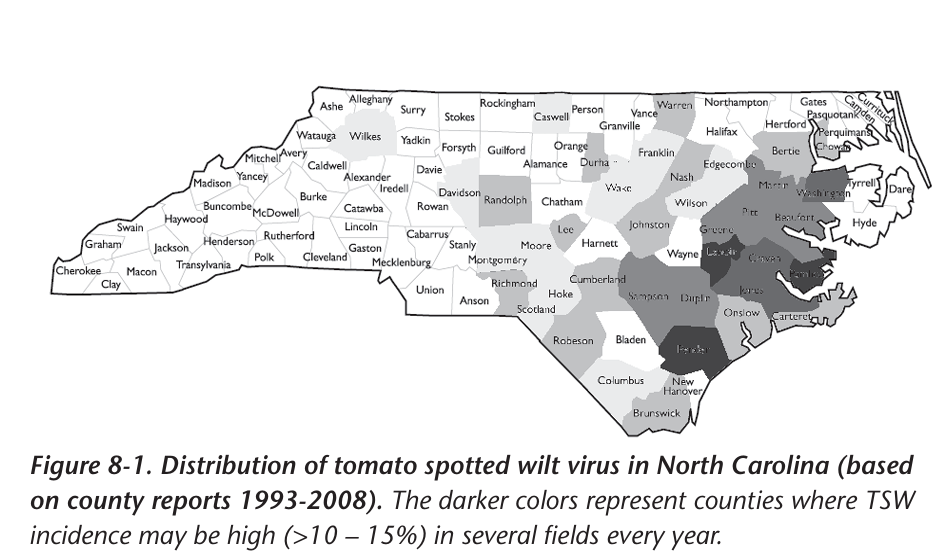Thrips Flight and TSWV Risk Assessment Report – April 23, 2025
go.ncsu.edu/readext?1069362
en Español / em Português
El inglés es el idioma de control de esta página. En la medida en que haya algún conflicto entre la traducción al inglés y la traducción, el inglés prevalece.
Al hacer clic en el enlace de traducción se activa un servicio de traducción gratuito para convertir la página al español. Al igual que con cualquier traducción por Internet, la conversión no es sensible al contexto y puede que no traduzca el texto en su significado original. NC State Extension no garantiza la exactitud del texto traducido. Por favor, tenga en cuenta que algunas aplicaciones y/o servicios pueden no funcionar como se espera cuando se traducen.
Português
Inglês é o idioma de controle desta página. Na medida que haja algum conflito entre o texto original em Inglês e a tradução, o Inglês prevalece.
Ao clicar no link de tradução, um serviço gratuito de tradução será ativado para converter a página para o Português. Como em qualquer tradução pela internet, a conversão não é sensivel ao contexto e pode não ocorrer a tradução para o significado orginal. O serviço de Extensão da Carolina do Norte (NC State Extension) não garante a exatidão do texto traduzido. Por favor, observe que algumas funções ou serviços podem não funcionar como esperado após a tradução.
English
English is the controlling language of this page. To the extent there is any conflict between the English text and the translation, English controls.
Clicking on the translation link activates a free translation service to convert the page to Spanish. As with any Internet translation, the conversion is not context-sensitive and may not translate the text to its original meaning. NC State Extension does not guarantee the accuracy of the translated text. Please note that some applications and/or services may not function as expected when translated.
Collapse ▲To help growers determine the potential of management practices for TSWV, we have created step-by-step guides on how to use the Tobacco Thrips Flight and TSWV Intensity Predictor to create Current Year TSWV Risk Assessments and Historical TSWV Predictions. Growers are strongly encouraged to create their own models using the information from their fields and season dates to plan for Tomato Spotted Wilt Virus (TSWV) management.
TSWV incidence was higher in 2024 than in previous years, possibly due to warm winter temperatures and spring conditions that maintained winter weed hosts of thrips longer than typical. This year, the 2025 TSWV incidence is expected to be lower than in 2024. However, the first two thrips flights happened approximately two weeks earlier than in 2024. Additionally, low rainfall during the spring and early summer could still contribute (in part) to thrips population increase.
Thrips Flight and TSWV Risk Assessments were conducted for four key tobacco-growing locations in NC:
- Kenly is a relatively low TSWV risk site (typically less than 8%), situated within large acreage production areas in Johnston and Wilson Counties.
- Kinston is a moderate TSWV risk site (typically less than 10%) in Lenoir County and also houses the NCDA & CS Cunningham Research Station, where extensive tobacco research is conducted.
- New Bern is a higher TSWV risk site (typically above 10%) in Craven County.
- Whiteville is a moderate to high TSWV risk site (around 8% or above 10%) in Columbus County and also houses the NCDA & CS Border Belt Tobacco Research Station where tobacco research is conducted.
For all these locations, the 3rd generation of tobacco thrips is expected to begin dispersing this week, as early as April 22 in Whiteville and late in the week as April 24 in Kenly. Following closely, the 4th generation of tobacco thrips is expected to begin dispersing as soon as this upcoming week (April 26) and early next week. Growers scheduled to transplant this week or next week, as well as growers that didn’t treat at greenhouse or during transplant, need to take precautions against these upcoming populations.
A greenhouse application of imidacloprid in combination with Actigard® is recommended to minimize potential losses to TSWV. If foliar applications of Actigard® are being considered, the sooner transplants are treated the better since it takes time for the product to be effective.
The third generation tobacco thrips flight is the generation that typically transmits the most TSWV.
Historically, thrips population flights were reported in the second week of May in most tobacco production areas in NC, but in the last few years we are having earlier flight and can continue to be the case in upcoming years. This means the populations are maturing faster than expected. We need to accommodate to these populations changes and start scouting and using the prediction tool earlier every year to protect tobacco transplants.
These models were created assuming no insecticide treatment and including the average historical TSWV incidence for each location (Fig. 8.1 included below from Mina, 2011).
The models used for this summary are attached below for your reference. In order to get the most accurate risk assessment, we recommend you enter your own farm data into the TSWV and Tobacco Thrips Risk Forecasting Tool and check for any updates frequently.
More Information



